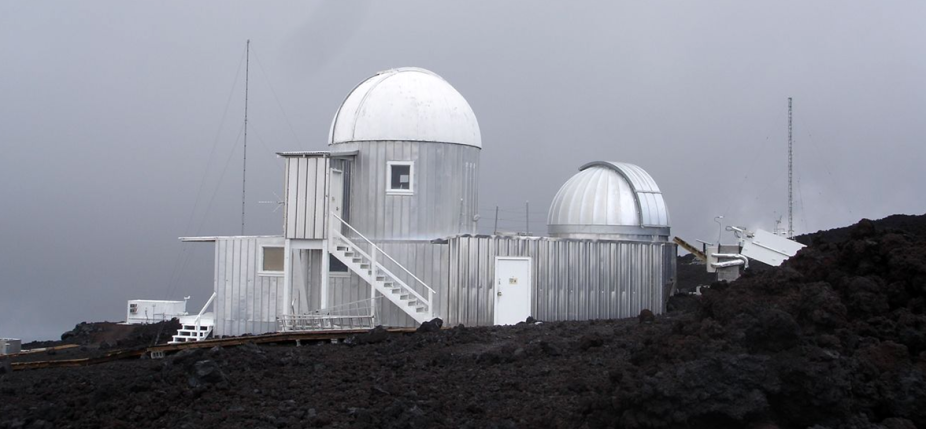
The domes of Mauna Loa Solar Observatory under rare cloudy skies (photo by Michael Thompson, NCAR Deputy Director, Mesa Lab, Boulder, CO).
Educational outreach is an important and rewarding part of an observer’s job at the Mauna Loa Solar Observatory (MLSO) site located on the flanks of Mauna Loa Mountain at an elevation of 3440 meters in the U.S. state of Hawai’i. MLSO is operated by the High Altitude Observatory (HAO), a division of the National Center for Atmospheric Research, which is located in Boulder, Colorado.
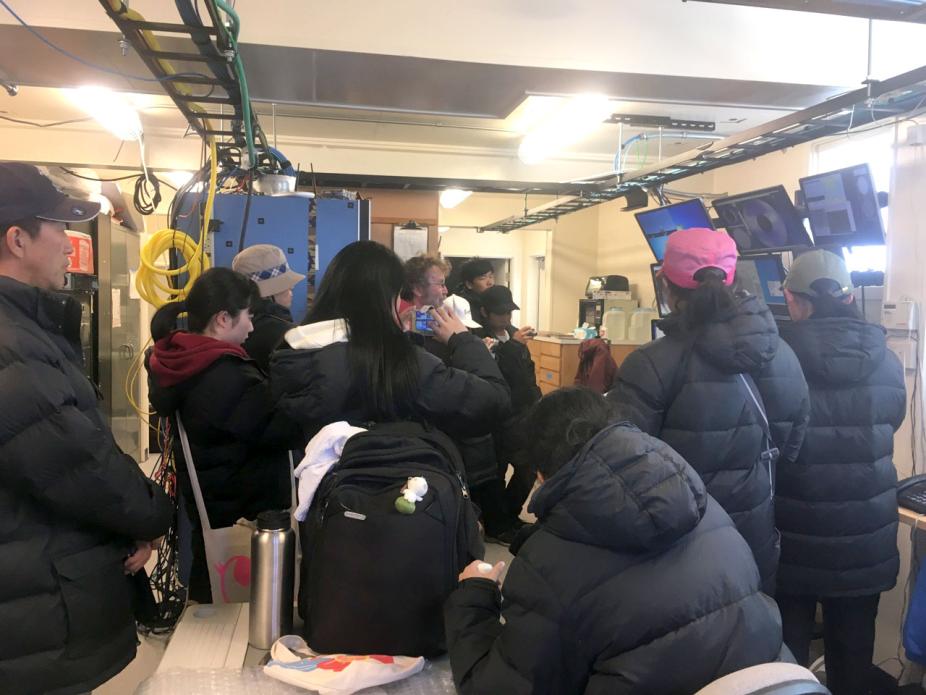
Allen Stueben, (center), giving tour to14 high school students from Namiki High school in Japan.
The MLSO staff gives tours to mountain visitors a couple times a month. These groups of visitors range from colleges in the solar to atmospheric sciences, members of the public and school groups. This year's highlights included 14 high school students from Namiki High school in Japan, HAO/NCAR directors, and a tour of about 30 people from the International Astronomy Teaching Summit conference that happened in Hilo this past summer.
MLSO staff also participate in various community outreach events organized by the local astronomy community. These events typically attract a few hundred visitors and give MLSO a chance to share recent activity at the observatory as well as explain solar phenomena. During the 2018 Astroday West Hawaii event, MLSO made the front page of the local paper with the display featured in the linked article and depicted in the photograph "Lisa Waters" below. (http://www.westhawaiitoday.com/2017/11/06/hawaii-news/astro-day-lifts-off/). This years Astroday focused on magnetic fields and effects on the sun (right up our alley). One of our hands on activities had kids try to find magnets hidden behind sun-spots with little compasses.
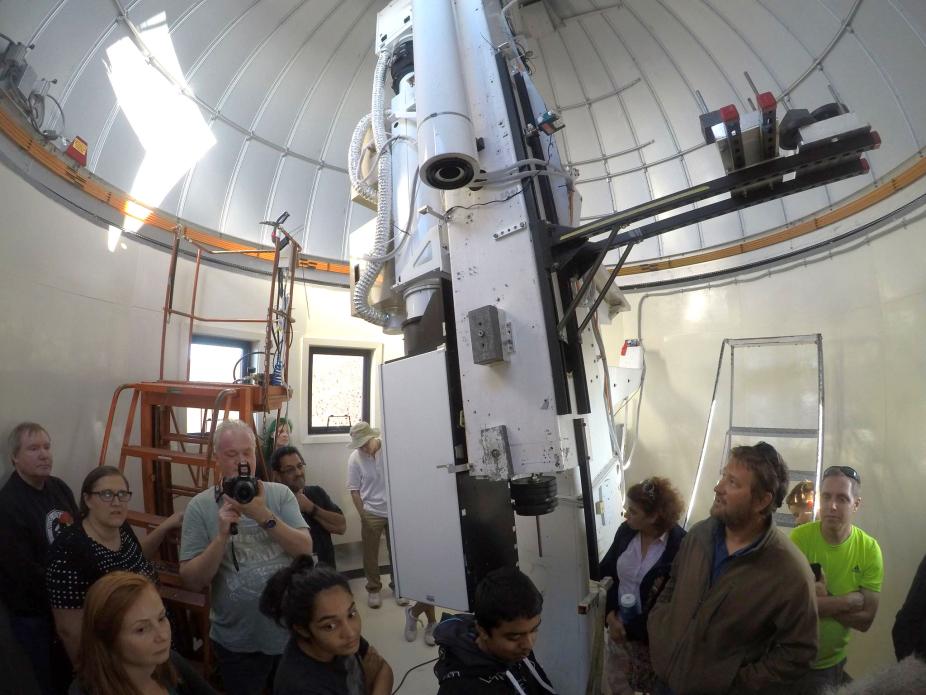
Ben Berkey (bearded, lower right) giving tour to 30 people from the International Astronomy Teaching Summit conference.
HAO employs two full-time observers (Ben Berkey and Allen Steuben), one 3/4 time (Lisa Waters), and one casual observer (Greg Rose) on the mountain. Working at high altitude is challenging and the road to the summit, called Mauna Loa Scenic Drive or Mauna Loa Observatory Road, is a roughly paved and narrow 17-mile drive that climbs at an average 4.98% grade. For most, the drive is a once in a life time trip, but for our intrepid MLSO team it is a weekly commute.
As Ben Berkey likes to say "the days are long but far between." He describes a day that begins at sea level (Hilo on the east coast) and well before sunrise. Then, in a race against time, he travels upward along a treacherous road gaining thousands of meters in elevation. With luck, over an hour into the drive, he will emerge above cloud level into a clear sky; the world begins to brighten. At this point it is still a half an hour of travel and additional thousands of meters to gain while winding through a stark landscape of barren mounds of a'a or lava. Upon arriving at the observatory "temple", devoted to the study and tracking of the sun, it is a sudden flurry of activity to begin the day's tasks. Sleeping computers must be awakened and inspected to ensure their readiness for the work to come. In preparation, the great record-keeping tome must be opened to a fresh blank page. Next, ascending the telescope steps to inspect and clean the instrument, and finally the sun has emerged from the mountain and the great dome doors can be opened; let there be light! With great effort and much precision push and pull of the instruments, the tracking of the sun's progress begins. Now it's time to watch and wait. Clouds and moisture can be an issue and then the dome has to be closed and the daily observation mission aborted. If this were to happen there is always plenty more to do...caring for instrumentation is one of many top priorities, –lubricating moving parts, changing codes, and doing general building maintenance is required too.
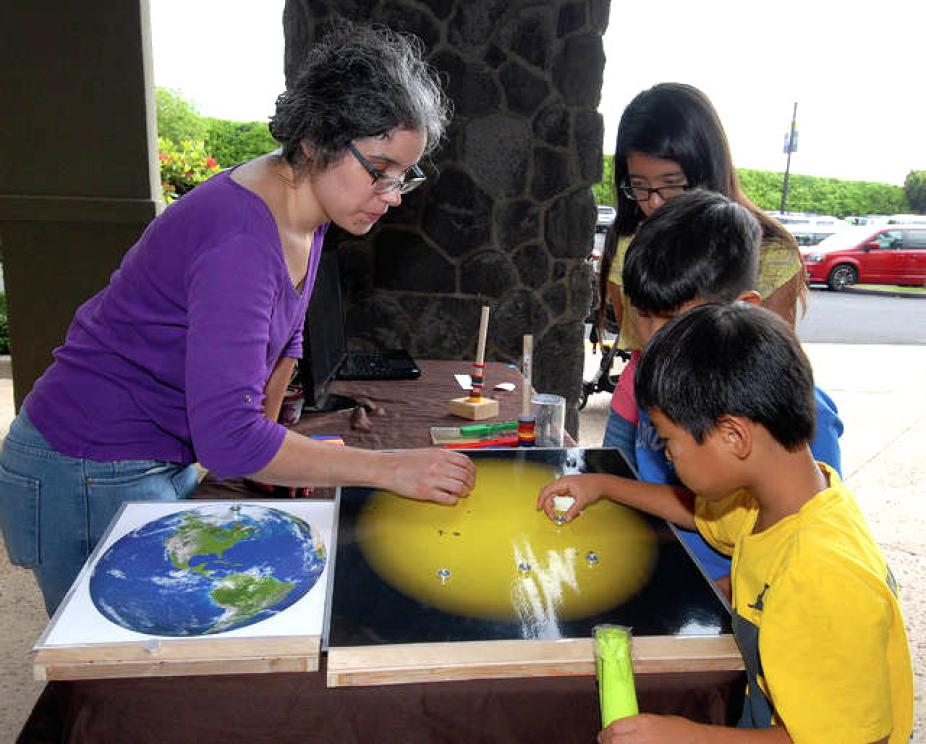
Lisa Waters demonstrating magnetic fields and effects on the sun at the local astronomy community event, Astroday in West Hawaii.
All these daily labors of love are done by this sparse crew and they work mostly alone. They welcome the rare occasions when visitors arrive for educational tours and they have the opportunity to share the facility, equipment, and the solar science. On some occasions, when big equipment and/or heavy parts must be managed, then contractors are hired (MLSO installed a new dome in January 2016). As day light fades, the instrumentation is parked and the great doors, if still open, are now closed for the night. Ben returns to the sea by the same lonely road, saluting the sun as it falls below the horizon. It requires a unique and dedicated individual to handle the unusual working conditions at MLSO, an individual that can tolerate the extreme quite of this solitary and remote area, and a person that can accept the constantly changing and extreme weather conditions of a ruggedly high-altitude office location, but our team, the unsung heroes of Mauna Loa, seem to thrive.
Facts and figures:
3.5 hours driving, 10 hours on site.
Ben Berkey (Hilo, HI) and Allen Stueben (Kona, HI) are full time. Lisa Waters is 3/4 time. Greg is a casual.
Work schedule:
Ben works Monday, Wednesday, Friday.
Allen works Tuesday, Thursday, Saturday.
Lisa works as a floater, nominally every other Sunday with 3 other days of overlap with either Allen or Ben during a 2 week period.
Greg works ever other Sunday.
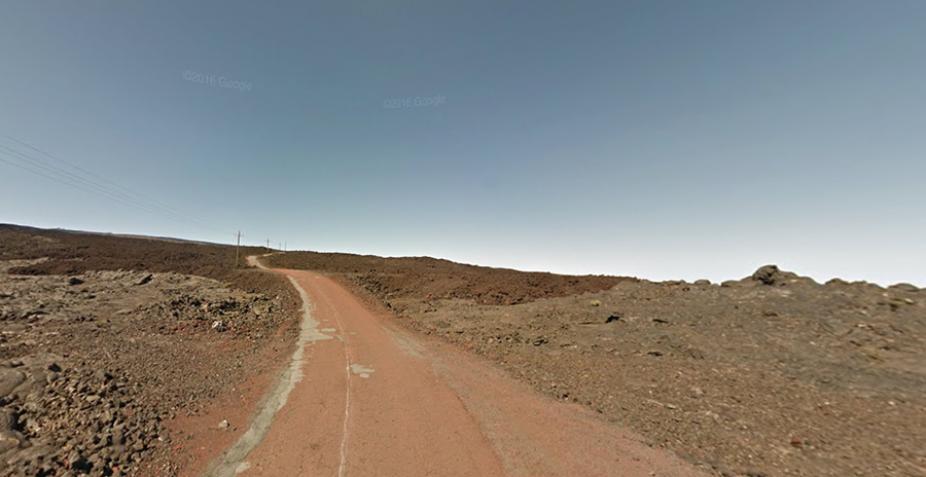
The road to Mauna Loa Observatory.
A note from Ben: The altitude tends to make things take a little longer than normal. People think slower and physical exertion is harder. We have a ~500 foot walk up the hill (~30 foot elevation gain) from the parking lot which often makes me feel a bit out of shape especially if I am jogging. Jogging might be required if some clouds roll in while I am at the restroom down by the parking lot and I need to hustle up to the observatory to close the dome or otherwise react.
Written by Ben Berkey and Wendy Hawkins.